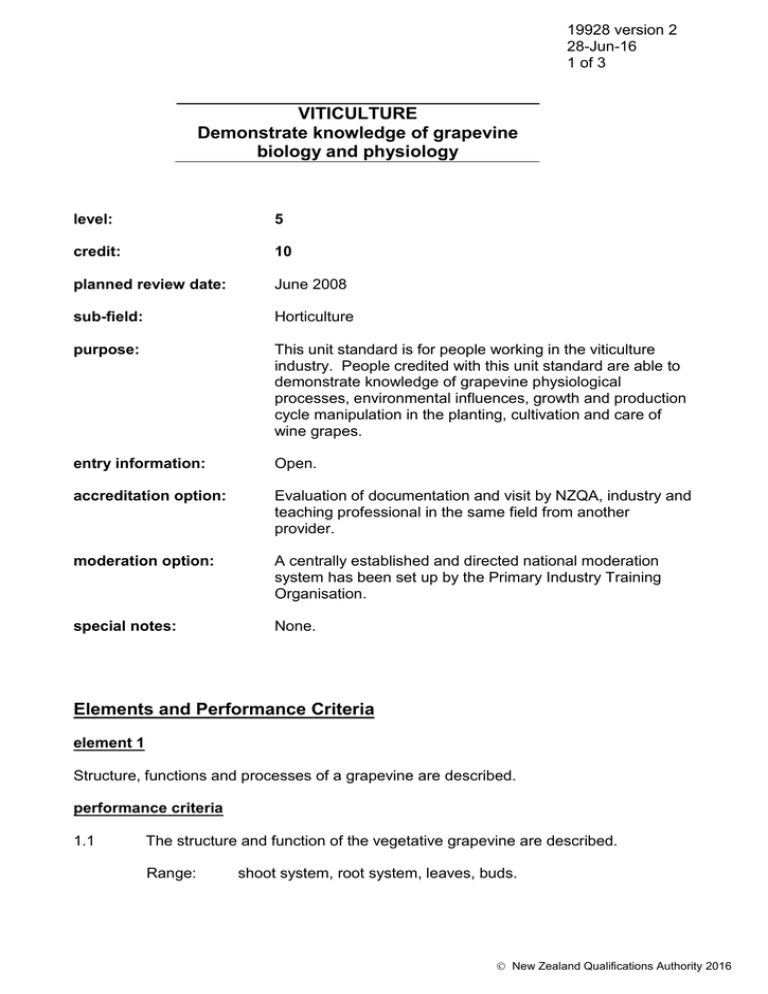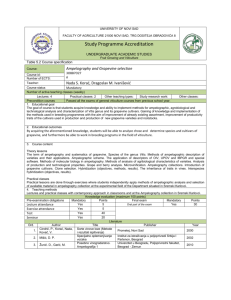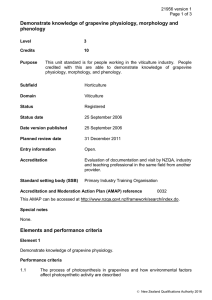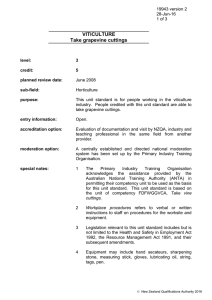VITICULTURE Demonstrate knowledge of grapevine biology and physiology
advertisement

19928 version 2 28-Jun-16 1 of 3 VITICULTURE Demonstrate knowledge of grapevine biology and physiology level: 5 credit: 10 planned review date: June 2008 sub-field: Horticulture purpose: This unit standard is for people working in the viticulture industry. People credited with this unit standard are able to demonstrate knowledge of grapevine physiological processes, environmental influences, growth and production cycle manipulation in the planting, cultivation and care of wine grapes. entry information: Open. accreditation option: Evaluation of documentation and visit by NZQA, industry and teaching professional in the same field from another provider. moderation option: A centrally established and directed national moderation system has been set up by the Primary Industry Training Organisation. special notes: None. Elements and Performance Criteria element 1 Structure, functions and processes of a grapevine are described. performance criteria 1.1 The structure and function of the vegetative grapevine are described. Range: shoot system, root system, leaves, buds. New Zealand Qualifications Authority 2016 19928 version 2 28-Jun-16 2 of 3 VITICULTURE Demonstrate knowledge of grapevine biology and physiology 1.2 The structure and function of the grapevine flower and berry are described. Range: 1.3 The growth processes of a grapevine are described. Range: 1.4 inflorescence, berry, bud. bud initiation, pollination, fertilisation, berry development, photosynthesis, respiration, translocation. The annual growth cycle of the grapevine is described. Range: bud dormancy, bud initiation, bud break, shoot and leaf growth, root growth, flowering, fruit set, berry growth, leaf fall. element 2 Explain the factors which influence the growth processes in grapevines. performance criteria 2.1 Internal plant processes are described in terms of how they affect grape growth. Range: 2.2 photosynthesis, respiration, transpiration, translocation and carbohydrate accumulation, nutrient uptake, berry development. The environmental influences, which impact on the internal processes of the grapevine are described. Range: temperature, water, humidity, light, shade, nutrition, wind. element 3 Demonstrate knowledge of plant physiology in the manipulation of grapevine growth or production cycles. performance criteria 3.1 Identification of perceived change in growth or production cycle provides basis for determining manipulation requirements. Range: early maturity, late maturity, improved yield, improved quality, grapevine balance. New Zealand Qualifications Authority 2016 19928 version 2 28-Jun-16 3 of 3 VITICULTURE Demonstrate knowledge of grapevine biology and physiology 3.2 Internal plant processes are described in terms of how they can be manipulated to achieve the desired results. 3.3 Planning determines which influences will be altered and by what amount to manipulate each growth process to meet the desired result. 3.4 Practical methods used to meet the desired result are described. Range: rootstocks, cultivars, site selection, row orientation and spacing canopy manipulation, soil management, pest and disease control, irrigation, frost control, weed control and shelter. Comments on this unit standard Please contact Primary Industry Training Organisation http://www.primaryito.ac.nz if you wish to suggest changes to the content of this unit standard. Please Note Providers must be accredited by the Qualifications Authority or a delegated interinstitutional body before they can register credits from assessment against unit standards or deliver courses of study leading to that assessment. Industry Training Organisations must be accredited by the Qualifications Authority before they can register credits from assessment against unit standards. Accredited providers and Industry Training Organisations assessing against unit standards must engage with the moderation system that applies to those standards. Accreditation requirements and an outline of the moderation system that applies to this standard are outlined in the Accreditation and Moderation Action Plan (AMAP). The AMAP also includes useful information about special requirements for providers wishing to develop education and training programmes, such as minimum qualifications for tutors and assessors, and special resource requirements. This unit standard is covered by AMAP 0032 which can be accessed at http://www.nzqa.govt.nz/site/framework/search.html. New Zealand Qualifications Authority 2016






